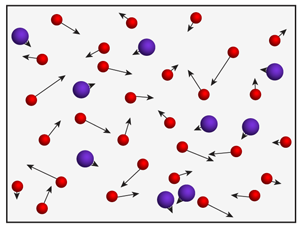What Temperature Really Measures
Temperature is a well known phenomenon. It is measured in countless avenues of our lives. But what is it?
Current scientific consensus defines temperature as a measure of thermal energy in all matter. It is then further described as a measure of the kinetic energy of the atoms involved; how quickly they are moving around.
This, though, does not describe the full story.
Only when we incorporate an infinite array of particles into our consideration can we determine the mechanics of the process.
There are ever larger and smaller mass particles relative to atoms, each following the laws of motion. Each particle is of equal complexity to the Earth; composed of subtler particles. And like atoms compared to planets, as particles are relatively subtler, they are also more abundant.
This abundance of subtler particles shapes the universe. It fills all of the apparent empty space of the observed universe with systems so completely that--next to the spaces left between atoms--the space between the systems observably approaches zero. It is at and around this region of frequency relative to atoms that the electromagnetic spectrum manifests.
But what about temperature?
It, too, is composed of subtle particles, where heat is a measure of the flow rate thereof. When a system is heated, it is physically radiated with particles that become temporarily gravitationally locked within the system, in the space between the more macroscopic particles of atoms. This, then, leads to an increased density of these particles. As a result, it is "as if" the overall system becomes high pressure.
This is because there are two forms of pressure.
Flows in the infinite universe can go in any direction. When a flow of energy is moving "down" through the layers, or generally sideways, where the systems exerting a force on other systems under consideration have sufficient mass to cause a greater or equal influence overall on the other system.
For instance, when we put our hand on something and apply a pressure, the systems involved in the analysis are similar; all are on the scale of atoms and electrons. This force is known as pressure.
But the flow of energy can also move up through the layers from below--from within--applying a counter flow, where the force being applied is not by systems of similar orders of magnitude such as atoms and electrons, but rather by the subtle as a collective which are able to flow through and penetrate the more gross and macroscopic systems.
This force--this counter-pressure within the universe, bubbling up from the underbelly, is able to be measured. The force is known as temperature.
If particles are removed from an environment by reducing the temperature thereof, then the environment does not disappear but rather transitions to a more subtle particle range filling the space. Importantly, particles in this environment, each like a star in space, gravitationally bring the environment's more subtle particles within the larger system and they fill space between the system's largest constituents, like subtle particles filling the space between the atoms of Earth.
As a result, conditions can be such that the subtle environment that is absorbed into the particle's innards become smaller and smaller.
And then they can reach a point where their subtlety is of the same order of magnitude as the particles of which magnetic fields are composed of. This causes a particle to transition to being ***high pressure relative to the particles of magnetic fields, and suddenly a system behaves superconductively. This is where, below a certain temperature, the system prevents magnetic fields from entering into them.
As temperature drops in a region, using the ideal gas law of PV=nRT and where volume is held constant, then pressure correspondingly drops. However, this is only pressure from a macroscopic standpoint. As temperature drops, subtle particles are broken into subtler and subtler systems that are simply more and more abundant to a point where there is an upward pressure applied. This upward pressure is distinctly inverse to the traditional downward pressure, as the infinite universe contains an apparent source on both ends of the spectrum. This further supports that nothing is everything and each are both one and the same; The Source.
The motions of atoms are but a result of this more fundamental root cause of their motions; without the seas rippling, the boats will be steady.
In a sense, pressure is also a top-down temperature. And both are more generally manifestations of one thing: force. The Force.

